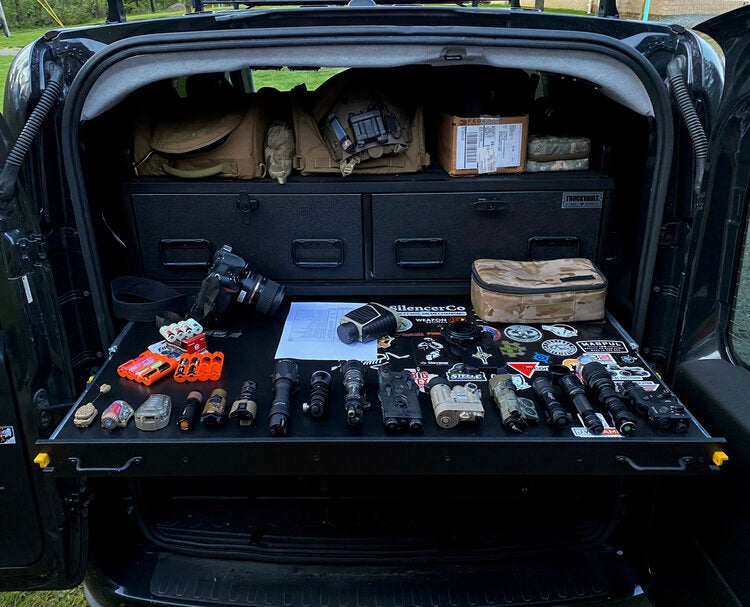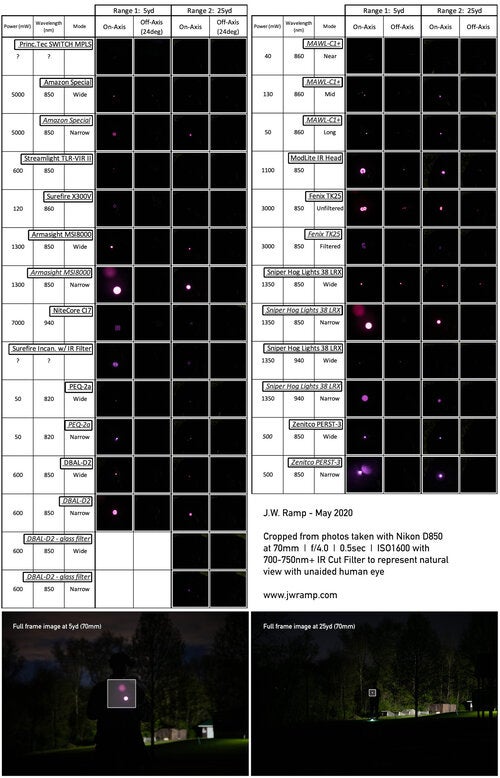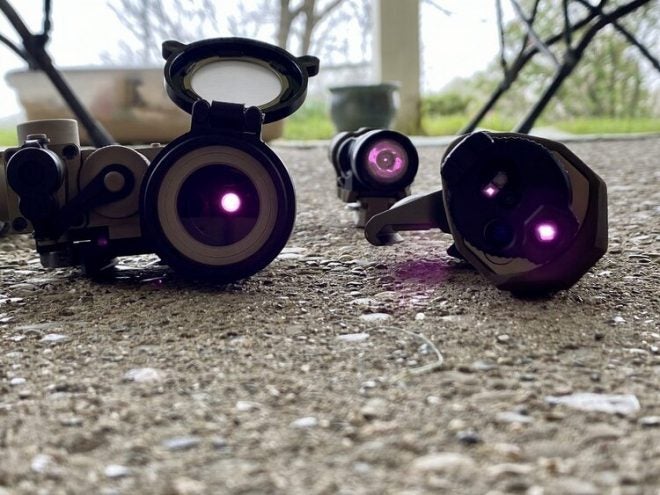Have you ever wondered what IR illuminators look like to someone on the receiving end? Certain SOP is to forgo the use of an IR lights or lasers and to just shoot passively for fear of the target downrange being able to see the glow of an IR device even without night vision. And while that is sage advice, how much does someone actually see with the naked eye? Well just last weekend, J.W. Ramp performed a much-needed test. He documented and photographed the downrange IR signature of some of the most common IR illuminators on the market. Such a comparison has never really been done before at this level.
Downrange IR Signature Test

Photo by JW Ramp.
Capturing the downrange IR signature of an infrared illuminator is easier said than done. While you could take something like a smartphone or a digital camera and photograph the illuminator shining at you, it is not what your eyes see. See the photo above. This was taken in broad daylight at point-blank range without any additional filter. Even though digital cameras have an infrared filter to cut IR light from hitting the sensor, they can still pick up some IR light and are more sensitive than the naked eye. So J.W. Ramp addresses this by using a filter that blocks NIR above 750nm, which should mimic what your eye can pick up. So with the filter in place, J.W Ramp goes downrange for science.

Some of the IR devices that were tested by JW Ramp.

DBAL-D2 on the left, Perst-3 on the right.
What is interesting is that even though the DBAL-D2 reportedly has a 600mW infrared LED illuminator, the PERST-3 seems brighter because it is a laser-based IR Illuminator. I reviewed the PERST-3 used in this test a while ago and I measured the illuminator to only be around 40mW instead of the published 500mW some websites claim. I think the laser illuminator will always be brighter since lasers are highly collimated. So their candela rating is always going to be much higher than an LED.

All the IR devices used in the test. Photo By JW Ramp.
Here are the devices for the test. Output levels are based on manufacturer claims. Some of these numbers are not accurate. Like the Amazon Special is not 5w of IR light.
Princeton Tec SWITCH MPLS – UNKNOWN OUTPUT
S&S Precision MANTA – UNKNOWN OUTPUT
CORE Survival HEL-STAR 640-09 – UNKNOWN OUTPUT
Amazon Special – 5000mW, 850nm
Streamlight TLR-VIR II – 600mW, 850nm
Surefire X300V – 120mW, 860nm
Armasight MSI8000 – 1300mW, 850nm
NiteCore CI7 – 7000mW, 940nm
Surefire Incandescent with IR Filter – UNKNOWN OUTPUT
PEQ-2a – 50mW, 820nm
DBAL-D2 – 600mW, 850nm
MAWL-C1+ – 130mW, 860nm at mid-setting
Sent in by others:
ModLite IR-850 Head – 1100mW, 850nm
Fenix TK25 – 3000mW, 850nm
Fenix TK25 – 3000mW, 850nm w/ 950nm glass filter
Sniper Hog Lights 38 LRX – 1350mW, 850nm
SHL 38 LRX – 1350mW, 940nm
Zenitco PERST-3 – 500mW, 850nm
Below is a chart with all the downrange IR signatures he captured with his camera. He cropped just the IR signature but below this chart, he shows what the full-size image looked like before he cropped it. He photographed each downrange IR signature four different times. The first set of photos were taken with the illuminator at just 5 yards away. He photographed them On-axis with each illuminator shining directly at the camera, then again with the illuminator off-axis at about 25 degrees. Ramp repeats his documentation at 25 yards for each device. He did not bother going any further because trying to see something an inch and a half wide lowly glowing red at say 100 yards might be possible but you would have to be looking directly at it.

The cropped images of the downrange IR signature for each light is a little hard to see in this format. For a higher resolution version of this image click here.
J.W. Ramp also documented each IR device from the sender’s POV. He made a similar video last year.
Here is the updated video from this year.
J.W. Ramp compiled screenshots of all the IR illuminators from the video above. Click here for a high-resolution copy of this image.
Some of the IR devices surprised me while others were obvious. I lent out my Modlite IR 850nM head for this test and I find that IR light to be too bright. It is 1100mW of IR light. That is 1.1 watt of IR light. Which is more powerful than any of the other IR illuminators in that test. I have said the MAWL-C1+ is the best MFAL and just look at the downrange IR signature, it is so minimal even though it beats a lot of these illuminators downrange in terms of illumination.
I would like to thank J.W. Ramp for taking the time to document this. Downrange IR signature is talked about a lot but rarely documented like this. You can follow more of J.W. Ramp’s work on his website.
 Your Privacy Choices
Your Privacy Choices
